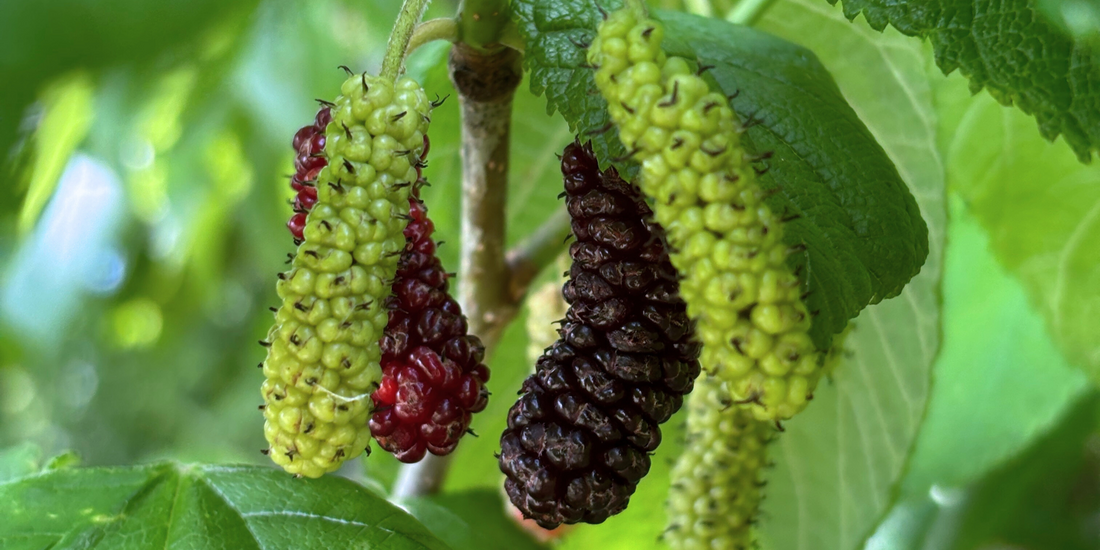
Caucasus x Appalachia | MULBERRY
Share
Fun topics below: silkworms, fruit leather, mulberry I.D.
Mulberries (Morus spp.) grow in both Georgia and the U.S. Here in Appalachia we have both native and introduced mulberries, which I’ll get into further down this page. Our woodlands here on the farm are dotted with red mulberry trees, and when we go on local hikes we usually come across a couple. They are part of the natural landscape, but there is so much diversity here that you can easily overlook them. Here, mulberries are attached to the wilderness. A tree for foragers, not homeowners. There have been times when I’ve seen a mulberry in someone’s yard and they had no clue what it was. Worse yet, some people have shown contempt for the tree’s capacity to litter the ground with its (delicious) fruit and stain everything it touches. I’m the opposite. I’ve grown to love my local mulberries, all the more so by observing mulberries in other parts of the world. Finding and savoring those clustered tree candies feels almost primal. It is a wild, solitary experience.

But in Georgia it feels different. Mulberry trees there, with their giant, twisting trunks and Edenic luscious fruit, give off an ancient energy. Not the ancient energy of a virgin forest but one that reflects the deep history of humans and cultivation. Mulberries have cemented themselves into various agrarian cultures because they fall into that category of venerated plants that feed human desire - the desire for food, for tools and goods, for symbolism and meaning, the list goes on. The more you see of the world the more you notice mulberries. You see them on university campuses and in monastic gardens. You see them sprawling amidst the crumbling stone of centuries-old cities. Mulberries and cradles of civilization seem to go hand-in-hand. This is how it is in Georgia as well.

Whether in the capital city of Tbilisi or wandering through the countryside, I seemed to always be in the company of a mulberry tree. It’s crazy to think that some of the most gargantuan mulberries I came across weren’t there since the dawn of time but planted by people. And that the sweet fruit that touched and stained my lips had done the same to generations of people before me - conceivably from the very same tree. If I had to pick a single plant that (to me) most represents the Georgian culture, I’d have to say the grape. But the mulberry is a very close second.
SILK

Mulberries proliferated in Georgia by way of the human desire for silk. Do you recall learning about the Silk Road in school? It was an ancient network of trade routes that linked China with the West. This began around 130 BCE. Silk was one of the novel goods that came out of China, and boy was it popular! Silk came from China because China had the 2 biological requirements for silk production: silkworms and silkworm food. Silkworms feed on mulberry leaves, most commonly the white mulberry (Morus alba), which is native to China. In the wild there is a natural symbiosis between this species and the wild silk moth (Bombyx mandarina). That symbiosis was capitalized upon for silk production - called sericulture. It even resulted in the domesticated silk moth (Bombyx mori).
Once silk had made its mark on the Western world, it was only a matter of time before the trade secrets of Chinese sericulture got out and people started making silk within their own borders. Georgia was one such place where silk production exploded. This new wing of Georgian agriculture proved to be so economically advantageous that silk was at one time used as a currency itself, alongside silver and gold. I had the opportunity to visit the State Silk Museum, one of the oldest museums in Georgia, to learn more about the history of Georgian-specific sericulture. This museum is tied to the Caucasian Sericulture Station - a research institute and educational center of the Caucasus region established in 1887.

So much of this historical research is on full display at the museum. It’s a naturalist’s dream. Rooms are filled with mounted moth specimens, vials of preserved mulberry bits, cases of silk cocoons, the pressed leaves of various mulberry species and cultivars, sericulture tools, and more. To see centuries worth of data on this one topic is fascinating. It’s a testament to how popular silk once was and an explanation for why you stumble upon so many mulberry trees in Georgia.


Looking back through my field notes I’m reminded that sericultural identity still remains for modern-day Georgians. It is not some distant memory of the past. My young host, Mariam, remembers old women in her village with rooms filled with shelves for breeding silkworms. Mariam would help pick mulberry leaves for the worms. The Georgian silk industry all but collapsed with the fall of the Soviet Union, but that really wasn’t that long ago when you think about it. Who knows what the future holds for Georgian sericulture. Globalism and animal welfare ethics would suggest that it’s not bound to make a comeback any time soon. But I do know that I’ll always cherish the vintage silk scarf given to me as a present upon my arrival.
WHITE v. RED v. BLACK
Globally, the choice mulberry trees are largely categorized into 3 species: Morus alba (white mulberry), Morus nigra (black mulberry), and Morus rubra (red mulberry). In North America we have the native red mulberry and the introduced white mulberry. In Georgia, they have the black and white mulberries. Whether those are native or introduced is hard to say. Some sources will say that neither are native to modern-day Georgia, while other sources, notably Georgian sources, claim that the black and/or white are native. [I do often wonder if Georgia is the ugly step-child of anthropological and botanical research. They don’t seem to get nearly as much attention as other countries with early agricultural histories. And what do the terms “native”, “naturalized”, and “introduced” really matter anyways? When geographical borders, people, and animals have been in flux for centuries, is it really necessary to define origination? I digress. These are thoughts for another day]…We do know for certain that China is in the native range for the white mulberry and the place where sericulture began. Being the preferred species for silkworms, industrious humans spread the white mulberry far and wide. The white mulberry ended up here in North America, too, and really took off in the middle latitudes.
 Morus alba - white mulberry
Morus alba - white mulberry
Morus nigra - black mulberry 
 Morus rubra - red mulberry
Morus rubra - red mulberry
Categorizing mulberries strictly by fruit color has made things challenging for identification purposes because the “white” mulberry (Morus alba) can have white and dark fruit. Conversely, dark-fruited species will start out white-ish before ripening to a dark purple. If you are in North America and trying to tell the Asian Morus alba from the American Morus rubra, then there are better indicators like leaf features, habitat, and region. Here is a decent guide. The one caveat is that there still is a ton of misinformation on this topic. Even the guide I linked to is not accurately describing the leaf shape in my opinion. In my experience, Morus rubra does not have lobed leaves when mature. They look much more like the broadly ovate to heart-shaped leaves of the American linden (basswood). I’d recommend Sam Thayer’s Incredible Wild Edibles, which clears up these confusing topics much better than online resources.
 Taste-wise I prefer the dark-fruited mulberries to the white. The white ones are alluring because pure white berries aren’t as common in nature, but they aren’t nearly as flavorful as the dark purple ones. And of all the dark-fruited mulberries I’ve tried, I’ve liked my native Morus rubra the best. Lucky me! Even though they don’t always have a strong crop, the mulberries I do manage to get are long and hefty with all the best parts of a sweet berry with little to no bitter acidity or annoying seeds. I’d take it over a strawberry or blackberry any day of the week.
Taste-wise I prefer the dark-fruited mulberries to the white. The white ones are alluring because pure white berries aren’t as common in nature, but they aren’t nearly as flavorful as the dark purple ones. And of all the dark-fruited mulberries I’ve tried, I’ve liked my native Morus rubra the best. Lucky me! Even though they don’t always have a strong crop, the mulberries I do manage to get are long and hefty with all the best parts of a sweet berry with little to no bitter acidity or annoying seeds. I’d take it over a strawberry or blackberry any day of the week.
FOOD
Eating mulberries straight from the tree here on my farm always gets me to thinking about why mulberries aren’t a popular fruit crop here in America. Of course, the native mulberry would’ve been utilized by Native Americans. But why can I go to the grocery store today and find dragon fruit and out-of-season blueberries, but never a fresh mulberry? It’s claimed that mulberries aren’t in the commercial American market because they are labor intensive to harvest and have a short shelf life. Yes, ripe mulberries are delicate and ephemeral, but so are many other fruits. And just because a fruit crop has a short window of freshness doesn’t mean you can’t enjoy it year round. Humans have invented this wondrous technology called preservation.
Georgian markets have all manner of mulberries from fresh to preserved. Some of the ways Georgians harness the mulberry is through:

-
Distilled vodka from mulberries
-
Tklapi - fruit leather
-
Dried fruit
-
Bakmazi - pressed mulberry juice condensed into a shelf-stable syrup. Culinary and medicinal uses.
An interesting tidbit from the Georgian National Tourism Administration explains harvest stages and corresponding uses:
“Gathering mulberries has its own special process. First, an oil cloth is spread out below a tree, and then the tree is shaken. The first mulberries are less sweet and are put into a vessel for distilling vodka. A few days later, more mulberries are collected and used for the dried fruit rolls. Finally, two weeks after they started ripening, the mulberries are now at their sweetest and most suitable for Bakmazi. The remaining runt mulberries are then dried.”

I marveled at all of the dried fruit and fruit leathers (tklapi) at the markets during my time in Georgia. The colors were varied and vibrant, the textures and shapes so perfect. Being a kid of the 90s I’m no stranger to fruit roll-ups, but the fruit leathers in the market didn’t feel familiar in the least. Rather than elicit a hunger response, they made me think of pretty bolts of fabric or cardstock. I still don’t know how they get them to look so perfect. I decided to give a go at making a fruit leather this summer when I found myself with a decent amount of mulberries, picked from our woods and some trees Hunter found on our local college’s campus. It’s the most I’ve ever been able to forage. Wander to the recipe journal for more info on mulberry fruit leather.

It’s been a joy to observe mulberries at home and abroad. From the not-so-staightforward taxonomy to the varied human uses, mulberries have a story that is complex but worth unraveling. Like most plant stories, the mulberry one reflects the human story as well. It’s a plant that somehow beckons to every human archetype: the explorer of the wild, the forager, the farmer, the scholar, the historian, the weaver. It certainly brings out the adventurer in me, and I can’t wait to see what other mulberries I might encounter out there in this big world.
|| Wander here for more Caucasus x Appalachia series information ||
SOURCES & FURTHER READING:
https://www.worldhistory.org/Silk_Road/
https://www.treesandshrubsonline.org/articles/morus/morus-nigra/
https://www.treesandshrubsonline.org/articles/morus/morus-alba/
https://www.researchgate.net/publication/276271176_Silk_Production_in_Georgia_History_and_Development_Opportunities
